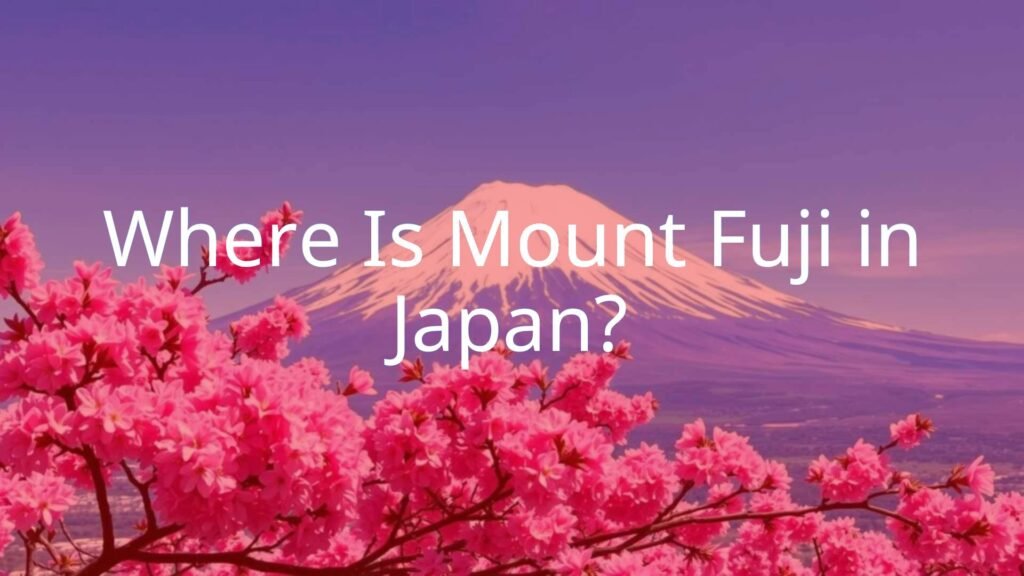Mount Fuji, called “Fujisan” by locals, is an active volcano on Honshu, the main island of Japan. Its near-perfect cone shape and frequent snow cap make it an instantly recognizable symbol of the country. This mountain, long considered sacred, is Japan’s tallest, standing as an important part of both nature and Japanese tradition.

In Which Prefectures Can You Find Mt. Fuji?
Mount Fuji sits on the border between Shizuoka Prefecture and Yamanashi Prefecture. Its base covers several towns and cities, such as Fuji, Fujinomiya, Fujiyoshida, Gotemba, Narusawa, and Oyama. Its location means you can see and reach it from various places, giving visitors different ways to enjoy its beauty and access it easily.
Depending on where you approach from, you’ll have different views and experiences. For example, the Fuji Five Lakes area, a favorite among travelers, is at the mountain’s north side, mostly in Yamanashi Prefecture. Each side brings its own local flavor and sights to those coming to see Mount Fuji.

How Close Is Mt. Fuji to Tokyo and Other Big Cities?
Mount Fuji’s closeness to Tokyo, Japan’s capital, helps make it so popular-especially with visitors from outside Japan. The mountain is about 100 km (62 miles) southwest of Tokyo. If the weather is good, you can sometimes see Mount Fuji from the Tokyo-Yokohama area-a wonderful view that impresses many. Its easy-to-reach location makes Fuji a great choice for short trips or longer journeys from Tokyo.

You can also spot Mount Fuji from cities like Yokohama and, on very clear days, even from Chiba, Saitama, Tochigi, Ibaraki, and Lake Hamana. When riding the Tokaido Shinkansen between Tokyo and cities like Nagoya, Kyoto, or Osaka, one of the best views is near Shin-Fuji Station (about 40-45 minutes after leaving Tokyo, if you’re on the right side of the train). Mount Fuji can often be covered by clouds; for the clearest view, early mornings, late evenings, and colder months are usually best.
Mt. Fuji’s Location, Height, and Details
| Coordinates | 35°21′39″N 138°43′39″E |
|---|---|
| Elevation | 3,776.24 meters (12,389 feet) |
| Prominence | 3,776 meters (12,388 feet) – 35th worldwide |
This makes Mount Fuji not just the tallest in Japan, but also one of the highest volcanic mountains on an Asian island and the seventh-tallest island peak in the world. Fuji has been built by many eruptions over a long period, with the current “New Fuji” volcano forming above an older volcano about 10,000 years ago. At the top, there is a crater about 780 meters across (2,560 feet) and around 240 meters deep (790 feet), surrounded by eight smaller peaks, including Japan’s highest spot, Ken-ga-mine.

Mt Fuji as Part of Japan’s Scenery
Mount Fuji isn’t just a big mountain-it’s part of a larger area full of natural attractions. It shapes the land around it, creating a unique place for hiking, sightseeing, and spiritual visits.
National Parks and Protected Spaces around Mt. Fuji
Mount Fuji is the centerpiece of Fuji-Hakone-Izu National Park, created in 1936 to preserve this special area. The park is recognized by UNESCO as a World Heritage Site called “Fujisan, sacred place and source of artistic inspiration” (since 2013), which includes Mount Fuji and 24 other sites such as temples and natural landmarks. This status helps protect not only the mountain but also the traditions and culture connected with it.
- Park area: 20,702.1 hectares
- Buffer zone: 49,627.7 hectares
- UNESCO World Heritage protection
The Fuji Five Lakes and Other Natural Sights
Five lovely lakes circle Mount Fuji: Lake Kawaguchi, Lake Yamanaka, Lake Sai, Lake Motosu, and Lake Shōji. These were made by old lava flows and offer some of the best views of the mountain, as well as good spots for photos, boating, and camping. Each lake has its own personality and things to do.

In addition, the area has many natural hot springs, forests, lava tubes, and other reminders of the volcano’s past activity. The lower slopes are covered in woods, making this region rich with plant and animal life. All these features come together to make the landscape special and interesting.
Aokigahara Forest and Its Position on Mt. Fuji
On the northwest lower slope is Aokigahara, known as the “Sea of Trees.” This thick forest grew on old lava from Mount Fuji. Some say compasses show wrong directions here due to the ground’s magnetic rocks. The forest is quiet and can appear mysterious or eerie.
Sadly, Aokigahara is known because of its connection to suicides; local officials have put up signs urging people to seek help. In the past, some families left their relatives there during hard times. Today, it’s both a place for walking and exploring, and a reminder of the area’s complex history. Hikers sometimes use colored tape to mark their paths, but this has led to worries about the effect on the environment.
How to Get to Mt Fuji
Whether you want to see Mount Fuji up close or climb it, there are several travel options. Japan’s transport system makes getting to Fuji fairly easy from different locations.
Ways to Get There and Closest Train Stations
The most common way is by train. If you’re heading to the Fuji Five Lakes area for classic views, Kawaguchiko Station is the main stop. From Tokyo, take the JR Chuo Line to Otsuki Station, then change to the Fujikyu Railway to Kawaguchiko. The train ride itself is relaxing and offers nice countryside scenery.
If you plan to climb, regular buses connect major train stations to Mount Fuji’s “fifth stations”-the base camps for starting an ascent. Although you can’t get right to the mountain base by train, combining train and bus makes the journey smooth for most travelers.
Getting There by Bus, Car, or Tour Group
Buses are a simple and direct choice, especially for those wanting to walk or climb during July and August, the main climbing season. You can catch direct buses from places like Shinjuku (Tokyo) or Yokohama, which will take you right to the main trailhead areas. Many hikers like buses because they avoid the trouble of finding a parking spot or driving unknown roads.
Alternatively, renting a car offers personal freedom and the chance to explore smaller towns and sights nearby, but can be crowded on busy days, and parking may be limited. Many people also choose guided tours, which take care of transport, entry, guides, and sometimes gear rental or places to stay. Tours are convenient for those who want a simple travel experience without having to plan each detail themselves.
Main Fifth Stations for Visitors and Hikers
There are four primary routes to Mount Fuji’s summit, each with a “fifth station” partway up. These fifth stations are reachable by bus or car and have shops, places to eat, and huts for rest. Each hiking trail has its own tenth station at the very top.
| Route | Fifth Station | Location | Notes |
|---|---|---|---|
| Yoshida | Subaru Line 5th Station | North side | Most popular; easiest from Tokyo; many buses and facilities |
| Fujinomiya | Fujinomiya 5th Station | South side | Highest fifth station; second favorite |
| Subashiri | Subashiri 5th Station | East side | Quieter; fewer crowds |
| Gotemba | Gotemba 5th Station | East side (lowest) | Longest and least climbed route |
Most people start their climb from a fifth station, taking around five to seven hours to reach the top. A few hikers begin at the very bottom (on less-used routes), but these require extra planning and effort.

- What Is a Maiko? - July 13, 2025
- What Does Domo Arigato Mean? - July 12, 2025
- What Does Naruto Mean? - July 12, 2025









